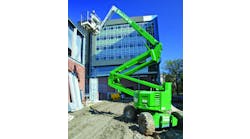Born in 1997 as a roll-up, United Rentals quickly grew to critical mass, becoming the rental industry's largest company within a year. Over the next few years, it acquired more than 250 companies, presenting United Rentals with the daunting challenge of molding together disparate corporate cultures, practices and philosophies.
The founding of United Rentals, spearheaded by the unique vision of Brad Jacobs, a consolidation specialist who perceived the fragmented nature of the rental industry and its potential to attract investors, was an extraordinary achievement regardless of how one feels about its favorable or unfavorable impact on the industry. With some in the rental industry saying it could never succeed, and periodically predicting its imminent demise, United Rentals has continually defied expectations, confounded its critics and surprised the naysayers. Like it or not, United Rentals has reached teenage years as a company and is weathering the storm of a severe recession with a strong balance sheet and a clear direction and vision. Now run by experienced rental veterans, United Rentals is coming into its own as an operating entity with an increasingly efficient structure and sophisticated technology that may help it increase its already-considerable market share.
Now led by Michael Kneeland, a 33-year veteran of the rental industry, who worked for Freestate Industries' rental division and leading aerial rental company Equipment Supply, United Rentals' management seems determined to not just react to current market conditions but to look ahead to where the company needs to go. The current United Rentals blueprint is an ongoing, evolving one as the company looks to stretch the limits of what a rental company can offer to its customers.
Independent, locally oriented rental companies might, on the other hand, look at United Rentals and see little in common with a company clearly re-aligning its market strategy to focus on larger companies. On the other hand, United has to deal with the same issues smaller independents do — how to handle rate pressures, service equipment and respond to breakdowns as efficiently as possible, and organize logistically to deliver equipment to jobsites with greater precision and immediacy. And to drive rental penetration; how to expand the scope of services and professionalism it can offer.
The current philosophies of United Rentals stem from an extensive study of its customers the company undertook in 2008, and an overall strategic program known as Operation United. The company wanted to determine who its customers really were, what they needed and wanted from a rental company. On a more detailed level, United Rentals sought to figure out if it was fully meeting customer expectations and what processes it needed to improve its ability to accomplish that. It sounds simple enough, but a basic rule of business, ignored and glossed over by many companies, is understanding customers' concerns and priorities better than one's competition does and meeting them more completely.
United hired a third party to carry out the survey to avoid bias, interviewing more than 1,800 customers and customers of competitors. Some of the responses were not surprising, others were. Overwhelmingly, responses focused on several key areas.
One of the main key points was that customers preferred to deal with a single point of contact.
“We changed our sales structure to a single point of contact,” says Kneeland. “If you're a Peter Kiewit or a Bechtel, or any large organization, you would have an assigned account person so that if you have any need or dispute, the point of contact is the person who makes things happen.” With United's new sales structure, local customers are handled the same way.
The second major concern, not too surprising, was on-time delivery and pickup. However, they found that what mattered most to the customer was communication. “We found that as long as we communicate with them, with a high degree of reliability, they're fine,” says Kneeland. “What they were telling us is that most [rental] companies are very poor at that. They'd say, ‘We request first-thing-in-the-morning delivery with the hope of getting it before noon.’ That's not where you want this industry to go, that's not good customer service.”
Another major concern — more of a surprise to United Rentals management — was billing accuracy. “That was eye-opening to me,” says Kneeland. “This was right in front of us, but we didn't see it! Basically what they said was, ‘We're not administrators; we like to build things, we like to get things done.’ The last thing they want to do is argue over billing or have a pile of paper on their desks.”
The survey also suggested that no rental company clearly stood out in meeting these criteria or overall service. Kneeland and his staff then set about trying to determine how to re-shape the company so that these concerns would be met and that United Rentals would stand out. They concentrated their efforts in several key areas.
Shareholder fleet
In the past, branch managers would be compensated, much like many multi-location companies, in accordance with revenues from their particular branch. Each piece of equipment in the United Rentals fleet was assigned to a branch, and how much revenue each machine brought in was purely a reflection of the performance of that facility. Branch managers would, therefore, have a natural tendency to hold on to equipment in case a demand arose for it at their branch.
As a result of Operation United, each machine became viewed as property of the company, or as United likes to call it, “shareholder fleet.” The decision on where to place fleet is no longer decided locally. In fact, points out Kneeland, “the compensation reinforces the process. The district manager is paid in part for the performance of his branch, but he is also paid in alignment with his district and trade area. So he benefits by making sure that if a branch 20 miles away has a demand for this 19-foot scissor and he doesn't, it's free game to transfer it.”
As a result, the sharing of fleet between branches, which always had enabled United to operate more efficiently, has burgeoned significantly.
“We finished 2009 with about 38 percent of our fleet moving between locations each month, meaning it started at the beginning of the month in one branch and ended at a different branch at the end of the month,” says Kneeland. “If you look at $3.8 billion of fleet, that's a lot of movement.” The result is a dynamism and fluidity that enables United Rentals to respond to customer needs with far greater immediacy.
Moving FASTer
Clearly as customers expected more efficient delivery and pickup, the company had to improve its logistical capability. The United Rentals staff knew that greater efficiency in this area demanded far more sophisticated technology and set out to improve its processes and systems.
United Rentals put in motion a logistics system called FAST — an acronym for field automations systems technology, a system in use in some regions and will continue to be rolled out to the remainder of United Rentals facilities in the coming months. One of the components of FAST is using computerization for improved delivery and pickup efficiency. The computer tells the driver what to load and in what order and what to deliver and in what order, taking into account the quickest possible route. The system saves fuel and ensures the company doesn't have empty trucks passing each other on the roads. The system takes into account that the driver might know something about potential obstacles caused by road construction and he does have input into the process accordingly.
The FAST system helps to schedule deliveries as well. If a customer asks for an 8 a.m. delivery and it conflicts with an already-scheduled delivery, the system will suggest alternatives such as 7 a.m. or 9:30 a.m. for example. United has found that the majority of its customers are flexible as long as the options are communicated.
“Customers, we have found, don't have to believe we do everything right,” says Matt Flannery, United Rentals' vice president of operations. “When you show the customer that we may not be 100 percent, but you can show delivery within 15-minute increments and that we're within those increments 96 percent of the time, and that we're trying to fix the other 4 percent, and that we can show the decision makers in an organization that we are tracking this and that we value our response to them, that we're down to an average 3-hour response time on service calls, we can have honesty and communication.”
Ned Graham, United Rentals vice president of business development agrees, calling the FAST system “a game-changer.”
“We have competitors who do a very good job applying certain types of technology to solving their logistics needs, no question about it,” says Graham. “But FAST is a far more comprehensive approach to logistics and living up to what a customer expects. And it has a green element to it; we intend to significantly go paperless with our deliveries. And there are other things our employees are no longer going to be tasked with having to do on a daily basis because they have been eliminated. It's much more than a delivery system with a GPS.”
Optimizing rates
Rental rates have been a major topic in the rental industry over the past few years. Rates have plummeted dramatically, as often occurs when there is a glut of equipment during an economic downturn. Seeing the continuing downward spiral of rates — which has continued in the industry even as utilization has begun to improve — United Rentals decided to take matters into its own hands, at least as far as what it could control, that being its own rate structure.
United's management team determined that while a degree of discounting for targeted large customers is inevitable, there had to be a point where the company ensured itself a respectable return on invested capital. The company developed a price optimization software system called CORE (Customer Oriented Rates Excellence) where an account rep, using a handheld device, can look up rates for a particular customer. Coming into play also is a customer's rental history with the company as well as local considerations such as labor costs and utilization. Based on these and other factors, the system determines the rate. If the salesperson wants to go below the rate, he would need immediate, real-time approval from the district manager.
While other companies have degrees of accountability, United Rentals wanted its system to prevent exceptions before they occur rather than discuss them after.
“Most companies do exception reporting,” says Kneeland. “They have standards and processes, but the exception reporting is after the fact. We wanted to change that so we have a discussion up front about why we would be doing something. We set baseline rates and we have district manager approval.”
The handheld technology provides the account rep with account information and ways to reach the district manager instantly through voice or electronic messaging.
“It's using technology to help change the outcome,” says Kneeland. “It's basically optimizing assets and the customer so you can drive profitable growth, that's the whole key behind it.”
Flannery points out internal benefits as well. “Among all the branches in a particular area, we're going to quote the customer more consistently so the customer will have the same experience no matter what branch it goes to,” he says.
Keeping score
In analyzing performance, Kneeland and his management team knew — and customers clearly indicated this when expressing expectations — quick response in case of breakdown is of paramount importance. United Rentals did a complete review of all its procedures to look for ways to improve and instituted systems to measure its response time, which it regularly reports to customers.
United keeps detailed records on its performance and customers are impressed when their points of contact show them the scorecard and say, essentially, “Here is how we performed for you.” Illustrating the performance and how the company is working to improve its record is a strong point.
“If a 60-foot boomlift goes down in Manhattan, how long does it take to resolve that?” says Graham, taking a look at the records of a United Rentals branch located across the river in New Jersey. “From the time the phone rings and we log it in to the time the mechanic calls and says, ‘the customer is up and running,’ we can do it in less than four hours. That's not based on one or two calls, but on 90 service calls, and that's in metropolitan New York traffic. It's impossible to think we could have done that five or six years ago.”
Showing the customer that the company is aware of its performance history and constantly trying to improve it instills confidence.
To Graham, raising the bar is important, not only for United Rentals but for the industry as a whole.
“We need to think about the full-service customer offering, rather than simply renting equipment,” he says. “We need to think more comprehensively about solving customers' needs. In North America, rental penetration statistics argue for the fact that rental companies have not truly met customers' needs. If we were doing all the kinds of work we could or should be doing to address the customers' needs — information systems, availability of product, security of supply, innovation, the whole customer service experience — rental penetration would be 65, 75 percent rather than what it is now.”
Size does matter
Operation United also convinced the company to continue to concentrate on larger companies, which was part of the reason the company formed and began consolidating the rental industry to begin with. The creation of a national footprint in the U.S. and Canada — United Rentals operates in 99 of the 100 largest markets in the two countries — gives it the ability to serve national accounts anywhere they are doing business and gives it a unique competitive advantage.
“National accounts are very profitable for us,” says Kneeland, “because we do have that broad footprint and we do have that ability and the assets. We have the consistency and the single point of contact to earn more of their business. I believe the national account customer is the one that's going to have the lion's share of the business, even in a down cycle. They are well-financed, they are well-managed, and they have bargaining power. They have the bench strength that can take diverse jobs.”
To help professionalize United Rentals' sales force, the company hired Joe Dixon as vice president of sales, a seasoned industry veteran who has held executive positions with Hertz Equipment Rental Corp., Home Depot Rentals and JLG. In addition to upgrading sales staff's access to technology with laptops and other tools, the company has provided training to improve skills. It has provided subject matter experts in certain industries United is focused on, to enhance sales staff knowledge of the industries they are selling to. It also has brought in government-related experts to help sales to government entities, and recent one-source rental agreements with state governments such as Texas and Massachusetts illustrate the potential in this market as cash-strapped municipal and state governments are increasingly discovering that with a shortage of resources, rental is a far more economic way to get things done.
Outside the box
United Rentals has brought in some intriguing figures to its management team, which seems encouraged to think outside the box and come up with new ideas to help the company reach its potential. None of the executives have been more significant than William Plummer, chief financial officer, who has previously worked for Dow Jones, Alcoa, General Electric Capital and Mead Corp. Plummer, who was intrigued by United Rentals because of its philosophy and potential for growth, also liked the opportunity to work with a CEO who encouraged partnership and collaboration rather than a dictatorial style.
It would be difficult to overestimate the importance of Plummer's role as he works in a close partnership with Kneeland to define and implement company strategy on a day-to-day basis, in a manner far beyond the role of a typical CFO.
Plummer, in addition to his obvious financial responsibilities, has played a major role in helping the company develop technology and processes to meet its objectives. “Being involved in day-to-day operations seemed like an opportunity to me,” Plummer says. “The logistics side of the business, how the company delivers equipment, picks it up, flows it through its service processes, and links it with the information systems you need for reporting. When I began, I just assumed United Rentals — a big company, doing millions of transactions a year — would have to be world-class in the logistics side of the business. I figured it had to be UPS, Fedex and United Rentals right there with them. But it wasn't.”
That doesn't mean it can't be in the future and the company was well on the path to improvement in this respect when Plummer came aboard and has continued in that direction. “I spend a lot of time thinking about where our information technology stands today and where the opportunities are to improve it going forward,” he says. “Making sure the initiatives we have going are well-supported and well-executed.”
Helping to determine the company's future direction is a big part of Plummer's responsibility. “Right now, we're focusing on Operation United, we're focused on the customer segments that are important to us and how do we grow with those segments and what do we need to do to serve them better than anybody else,” Plummer says. “But at some point we're going to have penetrated the national accounts, industrial accounts, the large and strategic accounts to the point where the growth opportunity is diminished. I don't know where that point is, I don't think it's any time soon, but one of the things that I bring to the table is being able to think three, five years down the road and say, “Ok, where's the next leg of growth and what's the next leg of profit improvement out there? Is it acquisitions? Is it international growth? Is it growing in adjacent markets, not just equipment rental but something related to equipment rental? What are the adjacencies, how do we identify the opportunities?' So I see my role as being an important driver of that thought process, not by myself obviously. That's the fun part of the job.”
Plummer, who was trained as an engineer, calls on that education as he analyzes processes. He likes to look at the big picture and say, ‘Let's make sure we have got the plan laid out the right way, and let's make sure it all continually fits together so we're getting a better result.” And in all things, Plummer makes sure if money is to be spent, that it is spent intelligently and wisely with an eye to how the expenditure will bring return and how any potential venture will bring the necessary return on capital.
Plummer's experience in the capital markets is another attribute he brings to the table. “Being able to think about what the investors' perspective is, what the capital markets offer us and how to maneuver through the capital markets and the constraints in our debt facilities was natural for me,” he says. “Last year, the team and I looked at the capital structure and said, ‘OK, what are the challenges to that capital structure, where are the risks, what do we need to do to deal with them?’ So we did a number of financing transactions to help re-arrange our balance sheet to where it was, in my view, bulletproof.”
Graham, a former RSC executive who also owned his own independent rental company, also looks at the big picture in his business development role, including analysis of business processes. Graham believes the industry has huge reserves of untapped growth potential.
“Look what has happened in construction with the recession,” he says. “Peoples' balance sheets are destroyed. So why wouldn't we have an opportunity to drive rental penetration? There is no vested interest in the customer to buy equipment, unless, for example, it's a large road builder who is using a scraper 95 percent of the time. The reason they continue to own is because we have not provided the quality of service, level of consistency, and security of supply the customer needs. As an industry, we haven't done a sufficient job.”
Innovation in systems such as FAST and CORE are a big part of United Rentals' forward progress. The management team is also exploring alliances, such as its recently forged alliance with AMECO to provide equipment and site services and a range of newly evolving programs to industrial companies along the Gulf Coast.
As a publicly owned company, there are constraints regarding what it can say about future plans, and any company of course is reluctant to reveal too much for competitive reasons. However, now, more than any time in its history, United Rentals is creating new technology and looking at a variety of directions regarding its own future and that of the rental industry, thinking ahead, thinking creatively and considering its possibilities without restraint.





